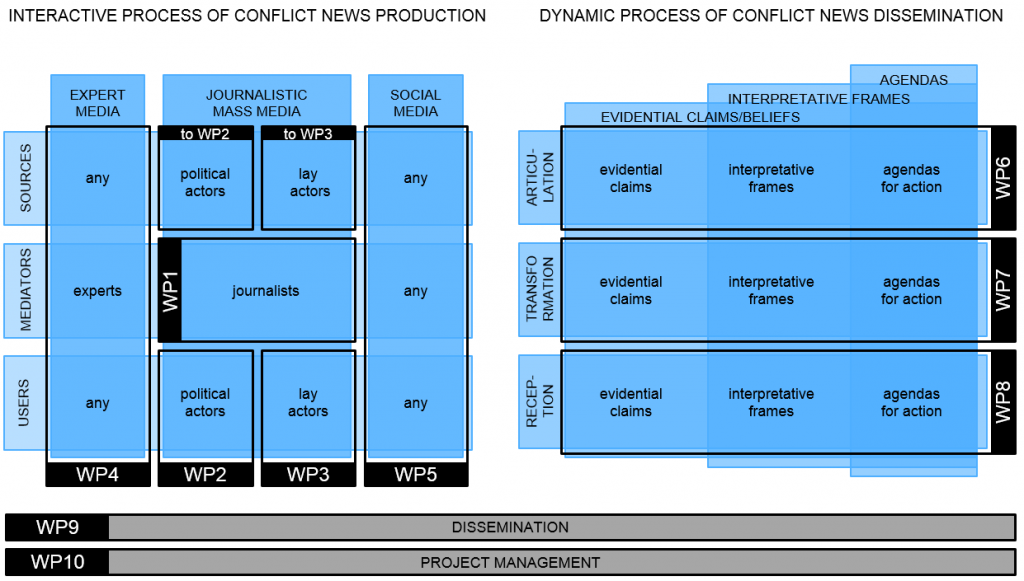Structure of the Project
INFOCORE comprises eight research Work Packages (WPs) that focus on different aspects of the production and dissemination process of conflict-related media content:
The first four Work Packages focus on those main actors involved in shaping the way media cover conflict:
WP1 investigates how Journalists operate in conflict, drawing upon various sources and interacting with their media organizations, news audiences, and various relevant authorities. (Mission Statement)
WP2 analyzes political actors’ strategies for both using media as information sources and influencing media reporting in specific ways during conflict. (Mission Statement)
WP3 addresses the role of lay media audiences both as recipients of conflict news coverage, and as important eyewitnesses and sources (e.g., through the use of social media). (Mission Statement)
WP4 focuses on the various roles of conflict experts – in think tanks and NGOs as well as the intelligence community – both as sources for media, media audiences, and conveyers of important information outside the classic mass media. (Mission Statement)
Together, these four WPs aim to reconstruct the complex interactive process by which conflict news is shaped. They thus address the production of media contents simultaneously from different, interconnected perspectives. This enables INFOCORE to gain a detailed, integrated understanding of the various influences and contingencies complicating news production in conflict. Accordingly, we can identify the main challenges to accurate and responsible media reporting, and define the access points for helping the media to report in a better, more constructive manner.
The second group of three Work Packages focuses on the main steps in the dissemination of conflict-related media content, from its production through its publication to its reception:
WP6 focuses on the conflict interpretations sponsored by strategic communicators (governments, military, NGOs, enterprises and others) advanced toward the media. (Mission Statement)
WP7 analyzes how source reports and strategic inputs are transformed in the coverage of the mass media into larger conflict narratives and journalistic analysis. (Mission Statement)
WP8 investigates in which ways media-disseminated conflict interpretations are mobilized in political debates and influence the direction of policy discourses. (Mission Statement)
Together, these three WPs aim to reconstruct the dynamic, recursive process through which media, audiences, and policy makers construct different interpretations and negotiate the socially accepted meaning of a conflict. Specifically, they trace the evolution of conflict interpretations over time and analyze how past strategic communication, media discourse and policy debates shape present and future frames and agendas for conflict response. This enables INFOCORE to identify important dynamics of debate polarization, propaganda, or reconciliation, and to describe characteristic patterns in conflict debates that are related to escalation and de-escalation. Accordingly, we can devise tools for using media as early indicators of impending escalation, and develop strategies for sustaining constructive debates.
The last research WP, WP5, focuses on the interactive evolution of conflict debates on social media. In doing so, it refers to all kinds of actor participating on social media, and links to various stages of the content dissemination process. It thereby connects both the production perspective of the first four WPs to the dissemination perspective of the last three WPs.
To ensure that all findings from INFOCORE are rendered available to both academic, professional, and other interested publics in an appropriate manner, high quality, and a timely fashion, WP9 takes charge of the project’s dissemination activities. WP10, finally, is charged with the administrative and financial management of the project.

